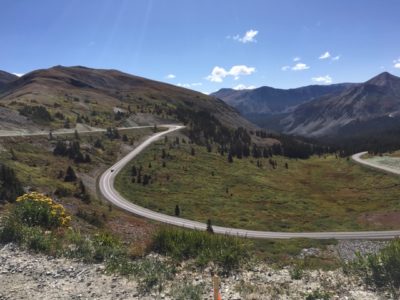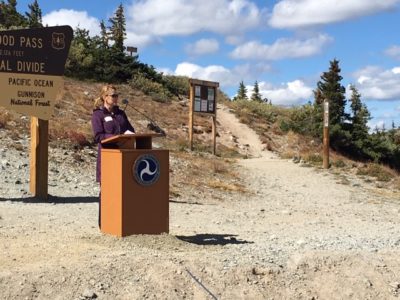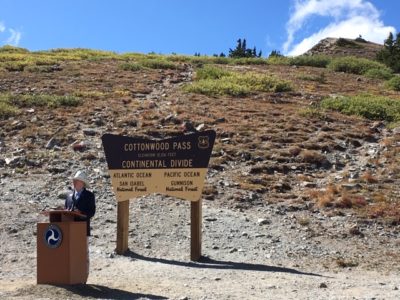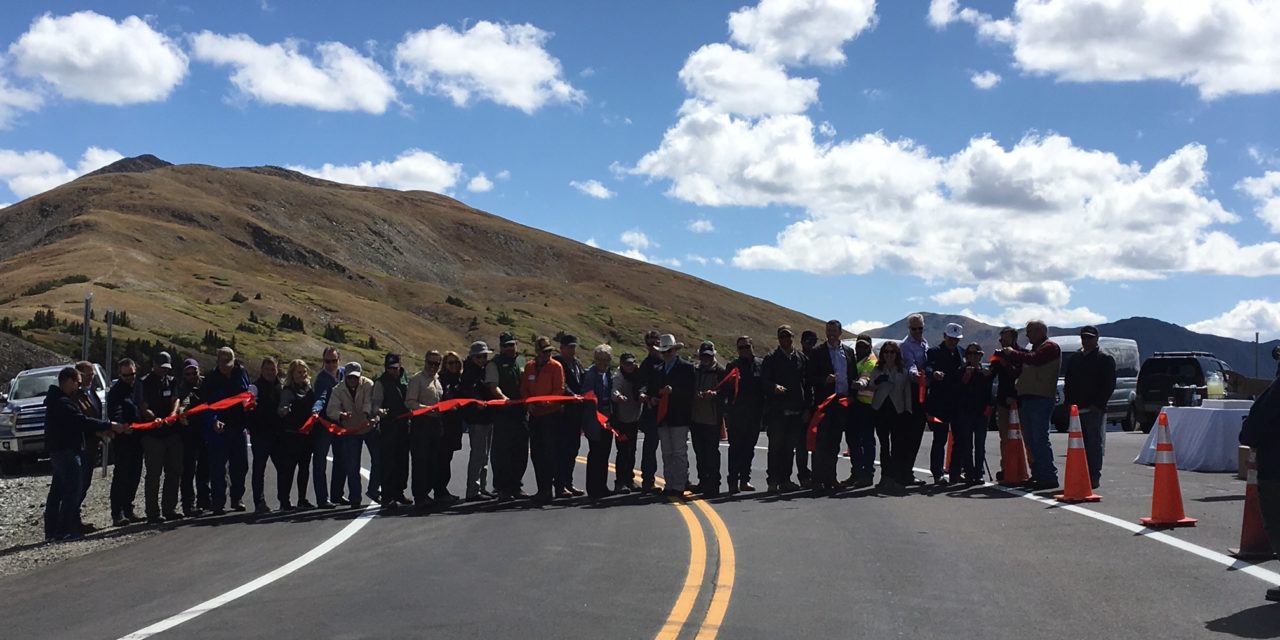It took three years, work crews with more than 120 people, around $34 million, and some 90 pieces of road-building equipment but Cottonwood Pass is finally open. As of the Sept. 19, with the grand opening of Cottonwood Pass, the second-highest paved pass in America is fully open to traffic again, just in time for the start of the fall foliage.
“An amazingly beautiful road,” commented person after person, standing in the crisp air on a spectacular morning, gazing out at the black ribbon of road weaving both directions down from the summit through the sprawling landscape. “Truly beautiful.”

The view from the summit of Cottonwood Pass, looking west toward Gunnison County. (Photos by Jan Wondra)
Some 45 officials representing Chaffee and Gunnison counties, the Federal Department of Transportation and Federal Highway Administration, the Colorado Department of Transportation, the U.S. Forest Service, and the general managers, project managers and road crews from United Companies and Kirkland Construction gathered to mark the occasion.
With the red ribbon stretched across the road summit, dozens of scissors clipped through the ceremonial sash. The 31 miles of re-engineered road (CR 306 on the Chaffee County side, CR 209 in Gunnison County) was officially open.
“The Central Federal Lands Highway Division is proud to be part of such an amazing and beautiful project,” said the Central Federal Lands Division Director Renee Sigel, whose department was responsible for the road design. I met her on the Continental Divide trail above the summit before the official remarks began, and the two of us stood there, taking in the expansive landscape.
“The partnership of the counties, the Forest Service, and the Department of Transportation has been a great example of what we can do together, to achieve a project that is going to benefit not just the counties, but the entire country,” added Sigel.

The view looking east from the summit of Cottonwood Pass, into Chaffee County.
At 12,126 feet, the Cottonwood Pass summit is now officially 37 feet below the highest pass in the country. That fact caused many to turn and look at the road cut rising on the north side of the road and exclaim good-humoredly “well, we maybe could have added that extra 37 feet.”
“Today is a celebration of many years of planning and work,” said the Federal Lands Access Program Manager James Herlyck, who acted as master of ceremonies. He pointed out that many people had waited decades, through a series of improvements, for the quality of road that now winds between Chaffee and Gunnison counties. Roughly between Taylor Park and Buena Vista.
The idea for the Cottonwood Pass road began in 1955 when the Forest Service needed a way to get timber out. Ernie Nesbit, then a young, Forest Service employee, started the work to map the road.

Central Federal Lands Highway Division Director Renee Sigel made early remarks during the grand opening celebration of Cottonwood Pass on Sept. 19.
“I was the assistant then, so I had to survey the center line,” said the long-retired Nesbit. “Summers I had help from college kids. But remember, we didn’t even have mechanical pencils or calculators back then. It was all done by hand labor. By 1958 we had a road – but it was dirt. We didn’t have good gravel with enough clay in it to bind it – so it took a lot of road maintenance back then.”
In the past 30 years, efforts were made to improve road conditions. A big leap was taken in 2013 when Gunnison County applied for federal lands access program funds (known as FLAP) to work on the Gunnison side of the pass. That work began in 2016.
That set in motion work on the eastern, Chaffee County side. Chaffee County Road and Bridge Superintendent Mark Stacy decided to explore making improvements to the top one mile of CR 306 from the pass. That raised the prospect of applying for federal funds to make more than minor improvements.
“When Stacy said’ we need to do some work up at the summit’, we were only going to do a mile or so,” said Chaffee Commissioner Keith Baker. “Then he and Ed Demming said ‘Let’s go big.’ I credit Ed with stepping up to help [the county] write the grant that got us the FLAP funding. I think we’re in a new era of cooperation.”

Chaffee Commissioner Keith Baker at the summit of Cottonwood Pass compared the newly-reopened road to the scenic federal parkways in the Great Smoky Mountains.
While work continued on the Gunnison County side (which required much more road re-engineering than the east side of the pass), work also began on the Chaffee County side.
The level of collaboration between the forest service and the road construction crews was extensive. Both were mindful of the economic need to keep the hiking trail access areas open so that outfitting businesses in both counties could continue to operate.
“What we have built is more than a road,” said Gunnison County Commissioner Jonathan Houck. “A road speaks to connecting things and beneath this road runs fiber optic cable. Between [Gunnison County] and Chaffee County is good connectivity. I don’t just mean the fiber optics – I mean it’s how we get things done here in the West. Meaningful actions happen through partnerships like this.”
Comparisons were made to the great vista drives in other parts of the country, many created with federal funding over the decades.
“I put this road on the same level with the other Federal Parkways like those in the Great Smoky Mountains, the Natchez Trace Parkway,” said Baker. “Driving this road, you get the same feeling – the sprawling landscape, the vistas. This is right up there.”
There was a strong sense of satisfaction for a job well done. The Forest Service (minus Jim Pitts, who was attending to the Decker Fire) wrapped up the morning celebration, pointing out that the 31 miles of road over Cottonwood Pass would be impactful for decades to come. Not only does the road now meet standards as a safe, reliable dependable motorway, but the U.S. Forest Service sees Cottonwood Pass as offering access to the unmatched backcountry and scenic beauty. “Inviting millions and millions of visitors in the decades to come – a bright and shining jewel in America’s scenic landscape.”








Recent Comments